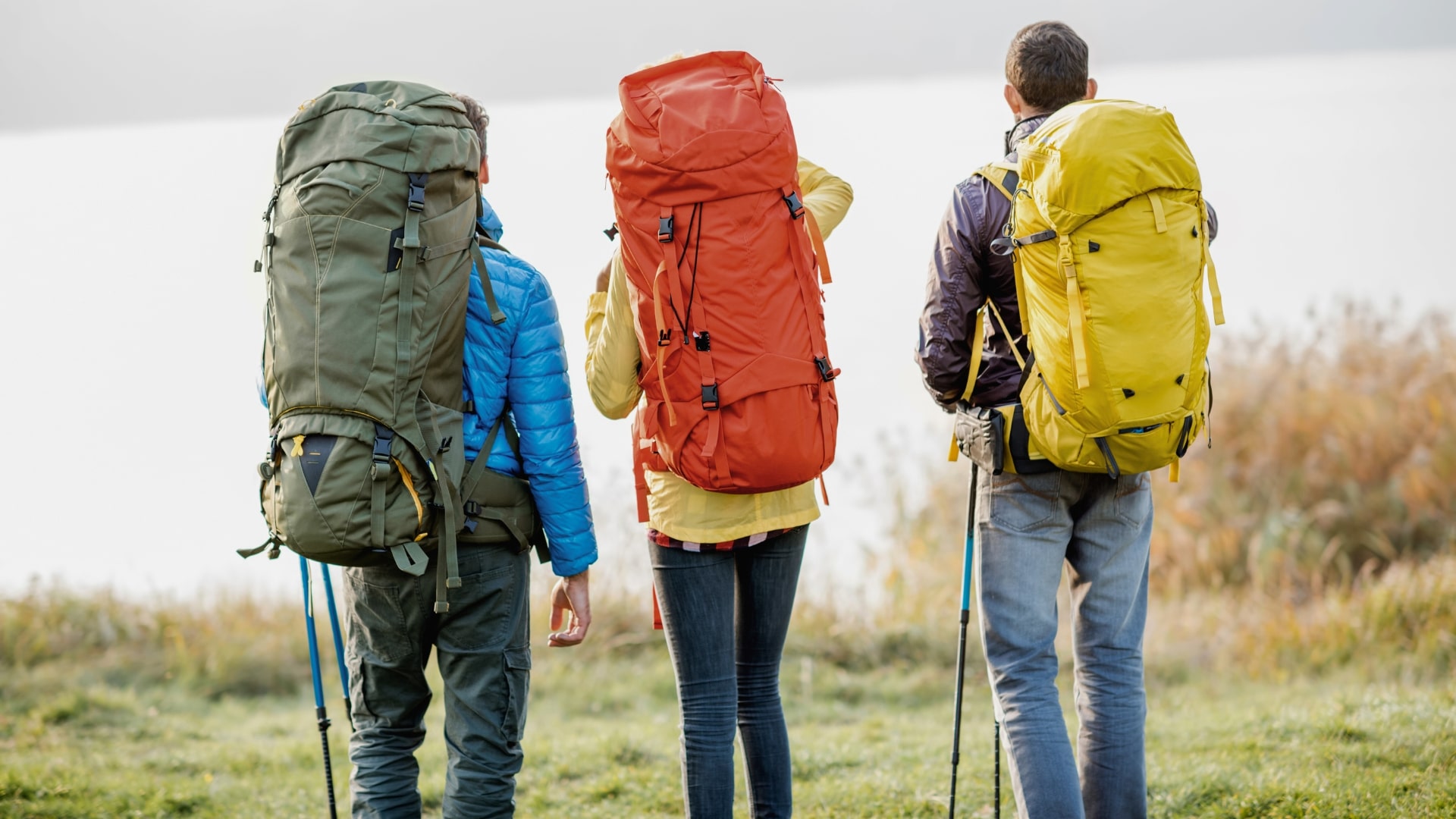
To choose a backpacking pack, first consider your hiking style: ultralight for minimalists, traditional for balanced comfort, or specialized for demanding environments.
Match the pack volume to your trip length; 40-50 liters for overnights, 50-70 liters for weekends, and 75-90 liters for longer trips. Ensure the pack can carry 35-40% of your body weight comfortably, with weight evenly distributed to your hips.
Proper sizing is crucial—measure your torso and adjust straps for a snug fit. Test the pack fully loaded to check comfort and stability. There are key details to optimize your pack choice you'll want to explore next.
When choosing a backpacking pack, consider your preferred hiking style, whether it's ultralight, traditional, or specialized like alpine mountaineering. Each style comes with its own set of needs and features that can significantly impact your comfort level and hiking pace.
For ultralight backpacking, the key is to minimize weight. These packs are designed with a lower weight carrying capacity, often sacrificing extra features to keep things light. While they excel in weight distribution to help maintain your hiking pace, you'll need to be meticulous about what you pack. Every ounce counts, so this style is best suited for experienced hikers who can forgo non-essential gear.
Traditional backpacking styles are more forgiving when it comes to gear. These packs offer a balanced approach, combining decent weight distribution with moderate comfort levels. They come with enough capacity to carry more substantial loads, making them ideal for multi-day trips where you might want a bit of extra comfort. If you're not ready to go ultralight but still want a functional pack for longer hikes, this is your go-to.
For those venturing into specialized activities like alpine mountaineering, packs designed for this purpose are essential. They've enhanced features to support technical gear and improved weight carrying capacity. The construction focuses on durability and specialized compartments, ensuring your gear stays organized and accessible. These packs also prioritize weight distribution to keep you steady on challenging terrain, without compromising your hiking pace.
Choosing the right pack volume is crucial to ensure you can carry all your essential gear comfortably. When you're looking at backpacks, you'll notice that pack volume is typically measured in liters or cubic inches, which indicates the carrying capacity of the pack. Understanding the appropriate pack size for your trip will make a significant difference in your comfort and efficiency on the trail.
For short overnight trips, a pack volume of 40-50 liters is usually sufficient. These smaller packs are ideal if you're not carrying too much gear and prefer a lightweight setup. They strike a good balance between capacity and portability, making them easy to manage even on less strenuous hikes.
Planning for a multi-day adventure? You might need a larger pack size. For weekend trips, a 50-70 liter pack is generally recommended. This size offers enough space for additional clothing, food, and gear, without becoming overly cumbersome. It's a sweet spot for those who want to be prepared without overpacking.
For those week-long or extended backpacking trips, you'll want to look at packs with a volume of 75-90 liters. These larger packs ensure you have the carrying capacity to bring all the necessary gear, food, and supplies for longer durations. They're essential for extended stays on the trail where resupply opportunities are limited.
Choosing the right pack volume is about matching the carrying capacity to the length of your trip and the amount of gear you need. By selecting the appropriate pack size, measured in liters or cubic inches, you'll ensure a more comfortable and enjoyable backpacking experience.
While selecting the right pack volume is important, understanding pack weight is equally vital for a comfortable backpacking experience. Knowing how much weight you can comfortably carry and how to distribute it effectively can make or break your trip.
A healthy adult hiker can generally carry 35-40% of their body weight in their backpack, with experienced hikers managing up to 40-50%. However, just because you can carry that much doesn't mean you should. A reasonable kit weight for three-season travel is around 20 pounds, including gear, food, water, and the backpack itself.
To ensure comfort, most of the pack weight should sit on your hips. This reduces strain on your shoulders and back, allowing you to hike longer distances with less fatigue. Look for packs with well-padded hip belts that can support and distribute the load effectively.
Efficient packing techniques are crucial for maintaining a manageable backpack weight. Organize your gear so the heaviest items are close to your back and centered between your shoulder blades. This keeps the center of gravity stable, which helps with balance and reduces the likelihood of back pain. Use compression sacks to minimize the volume of your sleeping bag and clothes, and consider multi-use items to cut down on what you need to bring.
A well-fitting backpack is crucial for ensuring comfort and efficiency during your hiking adventures. First, measure your torso length accurately. Knowing this measurement helps you choose a pack that fits your body, which is key for proper weight distribution. It's not just about height; torso length ensures the pack sits correctly on your back.
Next, focus on the hip belt. The hip belt should sit comfortably on your hip bones, not your waist. This is essential because your hips should carry most of the pack's weight, relieving stress from your shoulders. Adjust the hip belt so it's snug but not too tight, ensuring it supports the load effectively.
The shoulder straps are another critical component. They should wrap around your shoulders comfortably without digging in. Adjust them so the pack sits flush against your back, allowing for even weight distribution and preventing strain. Remember, the straps should be padded enough to provide comfort over long distances.
Load lifter straps play a crucial role as well. Positioned at a 45-degree angle between your shoulder straps and the top of the pack, these straps help pull the pack closer to your body, enhancing stability and balance. Tighten them to reduce sway and keep the load steady.
To ensure your backpack is a perfect fit, load it with your gear and walk around to test its comfort and balance. Start by filling the pack with the items you'll typically carry on your trips. This will help you assess its capacity and how well it handles the weight distribution. Don't just assume it will feel right; take the time to mimic real-world conditions.
Once the pack is loaded, put it on and walk around. Pay close attention to how it feels on your shoulders, back, and hips. This is your chance to assess comfort and fit. Notice any pressure points or areas where the pack might be digging in. If you feel discomfort, adjust the straps. The shoulder straps, hip belt, and sternum strap should all be tweaked to distribute the weight evenly across your body.
Weight distribution is crucial for avoiding fatigue and injury. Make sure the heaviest items are close to your back and centered in the pack. This helps maintain balance and keeps you stable. After adjusting the straps, walk around again and see if the changes have improved the fit.
For a thorough evaluation, test the pack on different terrains. Walk up and down inclines, and traverse uneven surfaces. This will give you a better sense of how the pack handles in various conditions. It's important to know that your pack won't shift or cause discomfort when you're on the trail.
Understanding your backpack's anatomy and making proper adjustments are key to ensuring a comfortable and efficient hiking experience. Knowing the key components of your pack, such as load lifter straps, sternum straps, and compression straps, can make a world of difference on the trail.
First, let's break down the pack anatomy. The shoulder straps should fit snugly but comfortably around your shoulders, ideally with some padding to prevent chafing. The hip belt is crucial for transferring the weight from your shoulders to your hips, which are better suited to bear heavy loads. Load lifter straps, located at the top of the shoulder straps, help to pull the pack close to your body, improving balance and reducing strain on your shoulders. Sternum straps, which connect the shoulder straps across your chest, provide additional stability and prevent the straps from slipping off your shoulders. Lastly, compression straps help to tighten your pack's load, keeping it compact and stable.
Adjustment is where you make all these components work in harmony. Start by loosening all straps and putting the pack on. Tighten the hip belt first so it sits snugly on your hips. Next, adjust the shoulder straps to bring the pack close to your back. Then, use the load lifter straps to fine-tune the fit, pulling the top of the pack toward your shoulders.
Buckle and adjust the sternum straps last to ensure the shoulder straps stay in place. Finally, use the compression straps to cinch down any loose parts of the pack, keeping everything stable and secure.
When choosing a backpacking pack, you'll find various styles tailored to different types of hiking adventures. Your choice will largely depend on your specific needs, such as pack size, hip size, and the duration of your trips.
For short, spontaneous outdoor excursions, day hiking packs are your best bet. These packs are smaller, usually ranging from 15 to 35 liters, providing just enough space for essentials like snacks, water, and a light jacket. Look for features like hydration compatibility so you can easily stay hydrated on the go.
If you're planning overnight trips, consider a mid-sized pack, typically ranging from 35 to 50 liters. These packs offer more space for additional gear like a sleeping bag, stove, and extra clothing. Make sure to choose one with adjustable straps to fit your hip size comfortably, ensuring even weight distribution.
For longer adventures, extended trip packs are essential. These packs often range from 50 to 70 liters or more, providing ample room for everything you might need over several days or weeks. They usually come with extra features like multiple external pockets for easy access to essentials and robust frames for better weight carrying capacity. Ensure your pack has good hydration compatibility and possibly trekking pole attachments for added convenience.
No matter the style, always prioritize comfort and fit. A well-fitting pack should sit comfortably on your hips and shoulders without causing strain. Take the time to adjust the straps and test the pack with your gear before committing.
Now that you know the essentials, you're ready to choose the perfect backpacking pack. Remember to identify your needs, focus on the right size and weight, and prioritize comfort.
Don't skip the crucial step of testing the pack with your gear. A well-fitting pack can transform your outdoor experience. Trust the advice of knowledgeable salespeople and pay attention to pack anatomy and adjustments.
Happy trails and enjoy every adventure with your ideal backpack!
Yes, a 50L backpack can be big enough for a 3-day trip if you pack efficiently. Use compression sacks and prioritize essential gear. Ensure it accommodates your specific needs and feels comfortable when fully packed.
A 70L backpack isn't too big if you're planning extended trips or carrying bulky gear. It offers ample space and comfort, but remember to test it with your gear to ensure it suits your needs.
You'll need to consider your trip's length and the gear you're bringing. Measure backpack sizes in liters; a 50-liter pack holds 50 Nalgene bottles. Consult salespersons and test packs to ensure a comfortable fit.
A hiking pack is smaller and designed for day hikes, focusing on lightweight and minimalistic features. A backpacking pack is larger, built for overnight trips, and prioritizes comfort, organization, and support for heavier loads.
